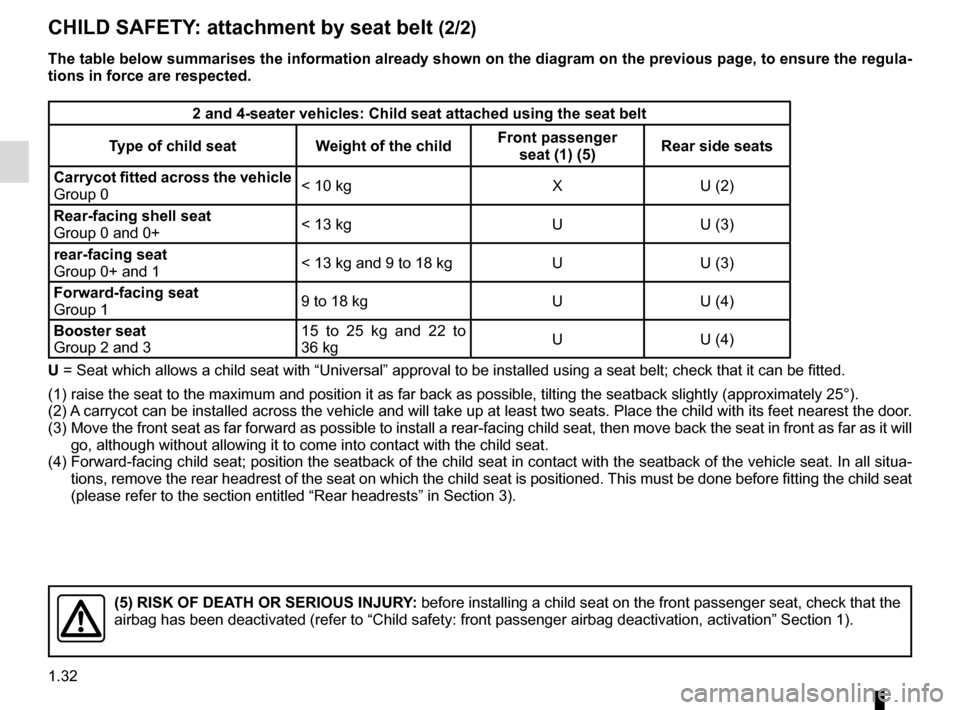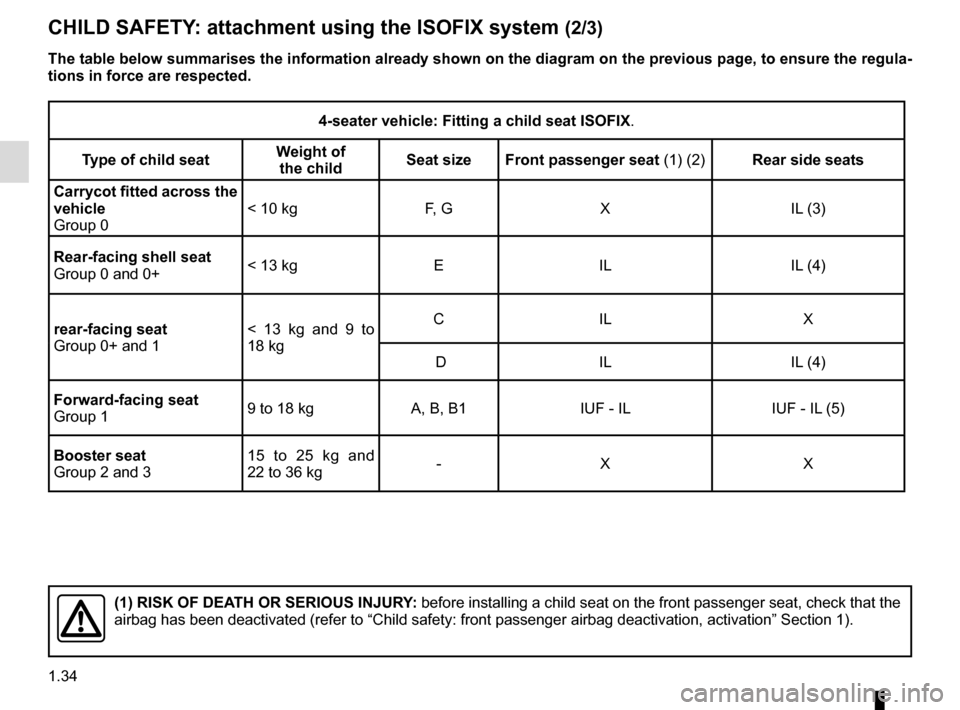diagram RENAULT TWINGO 2017 3.G Owners Manual
[x] Cancel search | Manufacturer: RENAULT, Model Year: 2017, Model line: TWINGO, Model: RENAULT TWINGO 2017 3.GPages: 228, PDF Size: 6.76 MB
Page 35 of 228

1.29
CHILD SAFETY: fitting a child seat, general information (1/2)
Some seats are not suitable for fitting
child seats. The diagram on the follow-
ing page shows you how to attach a
child seat.
The types of child seat indicated may
not be available. Before using a differ-
ent child seat, check with the manufac-
turer that it can be fitted.
Ensure that the child seat
or the child’s feet do not
prevent the front seat from
locking correctly. Refer to
the information on the “Front seat”
in Section 1.
Check that when installing the child
seat in the vehicle it is not at risk of
coming loose from its base.
If you have to remove the headrest,
check that it is correctly stored so
that it does not come loose under
harsh braking or impact.
Always attach the child seat to the
vehicle even if it is not in use so that
it does not come loose under harsh
braking or impact.
In the front seat
The laws concerning children travel-
ling in the front passenger seat differ in
every country. Consult the legislation in
force and follow the indications on the
diagram on the following page.
Before fitting a child seat in this seat (if
authorised):
– lower the seat belt as far as possible;
– move the seat as far back as possi- ble;
– gently tilt the seatback away from vertical (approximately 25°);
– on equipped vehicles, raise the seat base as far as possible.
RISK OF DEATH OR
SERIOUS INJURY: Before
installing a child seat on the
front passenger seat, check
that the airbag has been deacti-
vated (please refer to “Child safety:
front passenger airbag deactivation
and activation” in Section 1).
After installing the child seat, if neces-
sary, the seat may be advanced (so as
to leave enough space in the rear seats
for passengers or other child seats).
For a rear-facing child seat, do not let
it touch the dashboard or move it to the
furthest forward position.
Do not change other settings after in-
stalling the child seat.
Page 38 of 228

1.32
CHILD SAFETY: attachment by seat belt (2/2)
The table below summarises the information already shown on the diagram \
on the previous page, to ensure the regula-
tions in force are respected.
2 and 4-seater vehicles: Child seat attached using the seat belt
Type of child seat Weight of the child Front passenger
seat (1) (5) Rear side seats
Carrycot fitted across the vehicle
Group 0 < 10 kg X U (2)
Rear-facing shell seat
Group 0 and 0+ < 13 kg U U (3)
rear-facing seat
Group 0+ and 1 < 13 kg and 9 to 18 kg U U (3)
Forward-facing seat
Group 1 9 to 18 kg U U (4)
Booster seat
Group 2 and 3 15 to 25 kg and 22 to
36 kg
U U (4)
U = Seat which allows a child seat with “Universal” approval to be ins\
talled using a seat belt; check that it can be fitted.
(1) raise the seat to the maximum and position it as far back as possi\
ble, tilting the seatback slightly (approximately 25°).
(2) A carrycot can be installed across the vehicle and will take up at least two seats. Place the child with its feet nearest the door.
(3) Move the front seat as far forward as possible to install a rear-facing \
child seat, then move back the seat in front as far as it will
go, although without allowing it to come into contact with the child sea\
t.
(4) Forward-facing child seat; position the seatback of the child seat in co\
ntact with the seatback of the vehicle seat. In all sit ua-
tions, remove the rear headrest of the seat on which the child seat is p\
ositioned. This must be done before fitting the child s eat
(please refer to the section entitled “Rear headrests” in Section\
3).
(5) RISK OF DEATH OR SERIOUS INJURY: before installing a child seat on the front passenger seat, check that \
the
airbag has been deactivated (refer to “Child safety: front passenger\
airbag deactivation, activation” Section 1).
Page 40 of 228

1.34
CHILD SAFETY: attachment using the ISOFIX system (2/3)
The table below summarises the information already shown on the diagram \
on the previous page, to ensure the regula-
tions in force are respected.
4-seater vehicle: Fitting a child seat ISOFIX.
Type of child seat Weight of
the child Seat size Front passenger seat (1) (2)
Rear side seats
Carrycot fitted across the
vehicle
Group 0 < 10 kg
F, GX IL (3)
Rear-facing shell seat
Group 0 and 0+ < 13 kg
EIL IL (4)
rear-facing seat
Group 0+ and 1 < 13 kg and 9 to
18 kgCI
L X
D IL IL (4)
Forward-facing seat
Group 1 9 to 18 kg
A, B, B1 IUF - IL IUF - IL (5)
Booster seat
Group 2 and 3 15 to 25 kg and
22 to 36 kg
-X X
(1) RISK OF DEATH OR SERIOUS INJURY: before installing a child seat on the front passenger seat, check that \
the
airbag has been deactivated (refer to “Child safety: front passenger\
airbag deactivation, activation” Section 1).